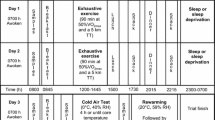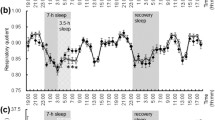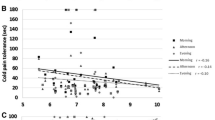Abstract
The purpose of the study was to determine the effects of two nights of sleep deprivation with or without energy restriction on immune indices at rest and in response to cold exposure. On three randomised occasions ten males slept normally [mean (SD): 436 (21) min night−1; CON], were totally sleep-deprived (SDEP), or were totally sleep-deprived and 90% energy-restricted (SDEP + ER) for 53 h. After 53 h (1200 h) participants performed a seated cold air test (CAT) at 0.0°C until T re decreased to 36.0°C. Circulating leucocyte counts, neutrophil degranulation, stress hormones and saliva secretory IgA (S-IgA) were determined at 0 h, 24 h, 48 h, pre-CAT, post-CAT, 1-h and 2-h post-CAT. One night on SDEP increased bacterially stimulated neutrophil degranulation (21%, P < 0.05), and two nights on SDEP and SDEP + ER increased S-IgA concentration (40 and 44%; P < 0.01). No other significant effects were observed for immuno-endocrine measures prior to CAT. CAT duration was not different between trials [mean (SD): 133 (53) min] and T re decreased to 35.9 (0.3)°C. Modest whole-body cooling decreased circulating lymphocyte counts (25%; P < 0.01), S-IgA concentration (36%; P < 0.01) and secretion rate (24%; P < 0.05). A neutrophilia occurred post-CAT on CON and SDEP and 2-h post-CAT on SDEP + ER (P < 0.01). Modest whole-body cooling also decreased neutrophil degranulation on CON (22%) and SDEP (18%; P < 0.05). Plasma cortisol and norepinephrine increased post-CAT (31 and 346%, P < 0.05), but modest whole-body cooling did not alter plasma epinephrine. In conclusion, two nights of SDEP or SDEP + ER did not compromise resting immune indices. However, modest whole-body cooling (T re 35.9°C) decreased circulating lymphocytes, neutrophil degranulation and S-IgA, but responses were not amplified by prior SDEP or SDEP + ER.




Similar content being viewed by others
References
Armstrong LE, Maresh CM, Castellani JW, Bergeron MF, Kenefick RW, LaGasse KE, Riebe D (1994) Urinary indices of hydration status. Int J Sport Nutr 4:265–279
Boyum A, Wiik P, Gustavsson E, Veiby OP, Reseland J, Haugen AH, Opstad PK (1996) The effect of strenuous exercise, calorie deficiency and sleep deprivation on white blood cells, plasma immunoglobulins and cytokines. Scand J Immunol 43:228–235
Brenner IK, Castellani JW, Gabaree C, Young AJ, Zamecnik J, Shephard RJ, Shek PN (1999) Immune changes in humans during cold exposure: effects of prior heating and exercise. J Appl Physiol 87:699–710
Castellani JW, Brenner IKM, Rhind SG (2002) Cold exposure: human immune responses and intracellular cytokine expression. Med Sci Sports Exerc 34:2013–2020
Chen AC, Rappelsberger P, Filz O (1998) Topology of EEG coherence changes may reflect differential neural network activation in cold and pain perception. Brain Topogr 11:125–132
Compher C, Frankenfield D, Keim N, Roth-Yousey L (2006) Best practice methods to apply to measurement of resting metabolic rate in adults: a systematic review. J Am Diet Assoc 106:881–903
Costa RJS, Cartner L, Oliver SJ, Laing SJ, Walters R, Bilzon JL, Walsh NP (2009) No effect of a 30-h period of sleep deprivation on leukocyte trafficking, neutrophil degranulation and saliva IgA responses to exercise. Eur J Appl Physiol 105:499–504
Dill DB, Costill DL (1974) Calculation of percentage changes in volumes of blood, plasma, and red cells in dehydration. J Appl Physiol 37:247–248
Dinges DF, Douglas SD, Zaugg L, Campbell DE, McMann JM, Whitehouse WG, Orne EC, Kapoor SC, Icaza E, Orne MT (1994) Leukocytosis and natural killer cell function parallel neurobehavioral fatigue induced by 64 hours of sleep deprivation. J Clin Invest 93:1930–1939
Giesbrecht GG (1995) The respiratory system in a cold environment. Aviat Space Environ Med 66:890–902
Gleeson M (2000) Mucosal immune responses and risk of respiratory illness in elite athletes. Exerc Immunol Rev 6:5–42
Gleeson M (2007) Immune function in sport and exercise. J Appl Physiol 103:693–699
Gomez-Merino D, Chennaoui M, Burnat P, Drogou C, Guezennec CY (2003) Immune and hormonal changes following intense military training. Mil Med 168:1034–1038
Guerrero JM, Reiter RJ (2002) Melatonin-immune system relationships. Curr Top Med Chem 2:167–179
Hollies NRS, Goldman RF (1977) Psychological scaling in comfort assessment. In: Hollies NRS, Goldman RF (eds) Clothing comfort: interaction of thermal, ventilation, construction, and assessment factors. Ann Arbor Science Publishers Inc., pp 107–120
Hucklebridge F, Clow A, Evans P (1998) The relationship between salivary secretory immunoglobulin A and cortisol: neuroendocrine response to awakening and the diurnal cycle. Int J Psychophysiol 31:69–76
Kruger K, Mooren FC (2007) T cell homing and exercise. Exerc Immunol Rev 13:37–54
Lackovic V, Borecky L, Vigas M, Rovensky J (1988) Activation of NK cells in subjects exposed to mild hyper- or hypothermic load. J Interferon Res 8:393–402
Laing SJ, Blackwell J, Gwynne D, Walters R, Walsh NP (2005) Neutrophil degranulation response to 2 hours of exercise in a 30 degrees C environment. Aviat Space Environ Med 76:1068–1073
Laing SJ, Jackson AR, Walters R, Lloyd-Jones E, Whitham M, Maassen N, Walsh NP (2008a) Human blood neutrophil responses to prolonged exercise with and without a thermal clamp. J Appl Physiol 104:20–26
Laing SJ, Oliver SJ, Wilson S, Walters R, Bilzon JL, Walsh NP (2008b) Neutrophil-degranulation and lymphocyte-subset response after 48 hr of fluid and/or energy restriction. Int J Sport Nutr Exerc Metab 18:443–456
Martinez-Lopez LE, Friedl KE, Moore RJ, Kramer TR (1993) A longitudinal study of infections and injuries of Ranger students. Mil Med 158:433–437
McCarthy DA, Dale MM (1988) The leucocytosis of exercise. A review and model. Sports Med 6:333–363
Moldofsky H, Lue FA, Davidson JR, Gorczynski R (1989) Effects of sleep deprivation on human immune functions. FASEB J 3:1972–1977
Oliver SJ, Laing SJ, Wilson S, Bilzon JL, Walters R, Walsh NP (2007) Salivary immunoglobulin A response at rest and after exercise following a 48 h period of fluid and/or energy restriction. Br J Nutr 97:1109–1116
Palmblad J, Cantell K, Strander H, Froberg J, Karlsson CG, Levi L, Granstrom M, Unger P (1976) Stressor exposure and immunological response in man: interferon-producing capacity and phagocytosis. J Psychosom Res 20:193–199
Palmblad J, Petrini B, Wasserman J, Akerstedt T (1979) Lymphocyte and granulocyte reactions during sleep deprivation. Psychosom Med 41:273–278
Proctor GB, Carpenter GH (2007) Regulation of salivary gland function by autonomic nerves. Auton Neurosci 133:3–18
Salin-Pascual RJ, Ortega-Soto H, Huerto-Delgadillo L, Camacho-Arroyo I, Roldan-Roldan G, Tamarkin L (1988) The effect of total sleep deprivation on plasma melatonin and cortisol in healthy human volunteers. Sleep 11:362–369
Shephard RJ, Castellani JW, Shek PN (1998) Immune deficits induced by strenuous exertion under adverse environmental conditions: manifestations and countermeasures. Crit Rev Immunol 18:545–568
Tiollier E, Gomez-Merino D, Burnat P, Jouanin JC, Bourrilhon C, Filaire E, Guezennec CY, Chennaoui M (2005) Intense training: mucosal immunity and incidence of respiratory infections. Eur J Appl Physiol 93:421–428
Todorovic VE, Micklewright A (2004) The parenteral and enteral nutrition group of the British Dietetics Association: a pocket guide to clinical nutrition. British Dietetics Association, pp 1–12
Tomasi TB, Trudeau FB, Czerwinski D, Erredge S (1982) Immune parameters in athletes before and after strenuous exercise. J Clin Immunol 2:173–178
Van Someren EJ (2006) Mechanisms and functions of coupling between sleep and temperature rhythms. Prog Brain Res 153:309–324
Walsh NP, Whitham M (2006) Exercising in environmental extremes : a greater threat to immune function? Sports Med 36:941–976
Walsh NP, Bishop NC, Blackwell J, Wierzbicki SG, Montague JC (2002) Salivary IgA response to prolonged exercise in a cold environment in trained cyclists. Med Sci Sports Exerc 34:1632–1637
Walsh NP, Laing SJ, Oliver SJ, Montague JC, Walters R, Bilzon JL (2004) Saliva parameters as potential indices of hydration status during acute dehydration. Med Sci Sports Exerc 36:1535–1542
Wenisch C, Narzt E, Sessler DI, Parschalk B, Lenhardt R, Kurz A, Graninger W (1996) Mild intraoperative hypothermia reduces production of reactive oxygen intermediates by polymorphonuclear leukocytes. Anesth Analg 82:810–816
Acknowledgments
The authors acknowledge the Headquarters Army Recruiting and Training Division, Upavon, UK for supporting the study.
Author information
Authors and Affiliations
Corresponding author
Additional information
Communicated by George Havenith.
Rights and permissions
About this article
Cite this article
Costa, R.J.S., Smith, A.H., Oliver, S.J. et al. The effects of two nights of sleep deprivation with or without energy restriction on immune indices at rest and in response to cold exposure. Eur J Appl Physiol 109, 417–428 (2010). https://doi.org/10.1007/s00421-010-1378-x
Accepted:
Published:
Issue Date:
DOI: https://doi.org/10.1007/s00421-010-1378-x




